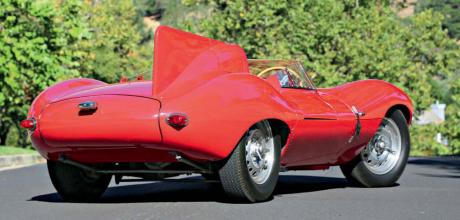1955 Jaguar D-type - life story of XKD518
Steve Natale recounts the life and times of a distinctive D-type, with connections to Formula 1 and Led Zeppelin, finally finding a home in the USA…
WORDS & PHOTOGRAPHY: STEVE NATALE
XKD518 STORYTHE HISTORY OF A D-TYPE IN AN UNUSUAL HUE
A VERY RED D-TYPEThe life story of XKD518, the sports racersroute to the USA
SEEING RED
Who painted this Jaguar D-type red?” was my thought when I first laid eyes on this legendary machine. Most Jaguar competition cars are BRG, or British Racing Green, a livery thought by many to be ‘proper’ for a car of this ilk. Sure a few black, blue, or even white cars are out there, but a bright red car stands out like a low-cut sequin cocktail dress at the Queen’s tea party. In answer to my question: it was born that way. Yes, Jaguar made this car and one other D-type, bright red with matching red seats. One theory is that it was intended to be sold new in Italy, where red is the color of preference for Italian racers, but the real reason for the color remains a mystery, adding to the mystique of one of the greatest racing car designs ever created.
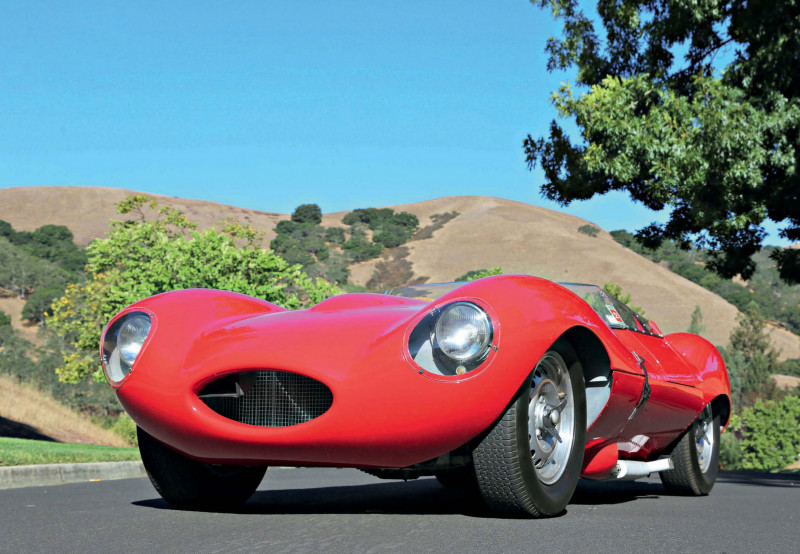
A LEGEND IS BORN
Jaguar began developing a replacement in 1953 for its C-type, the model that had helped cement the Coventry firm's international reputation for racing prowess with wins at Le Mans in 1951 and 1953. Under the direction of company founder William Lyons and chief engineer William Heynes, a state-of- the-art sports racing car began to form with an exciting shape that the world had never seen.
“We did some research and verified XKD518 was originally one of the two red on red D-Types produced by the factory.”
Using the latest advances in aircraft technology as inspiration, the D-type featured a high-strength alloy monocoque chassis, with load-bearing external panels and tubular subframes fore and aft. This fresh and innovative way to construct an automobile represented a radical departure from conventional automotive design; most automobile manufacturers did not implement similar technology until decades later. In addition to its revolutionary chassis, the D-type benefited from numerous other aviation-inspired features, including Dunlop disc brakes, a deformable fuel bladder, and dry sump lubrication.
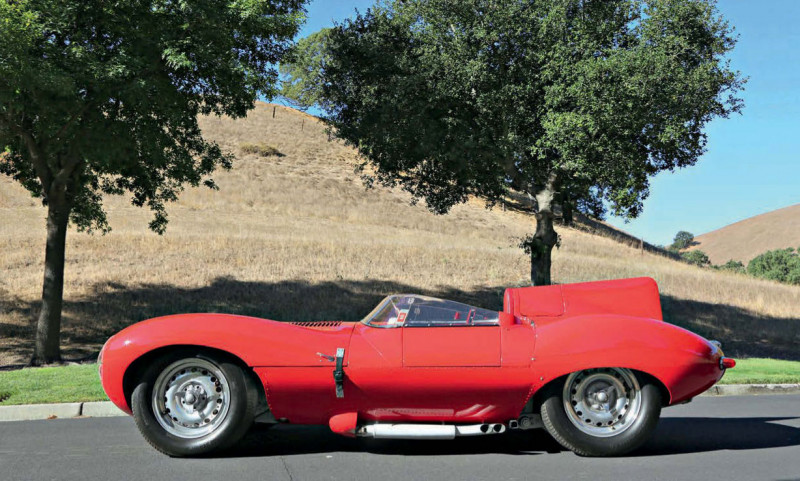
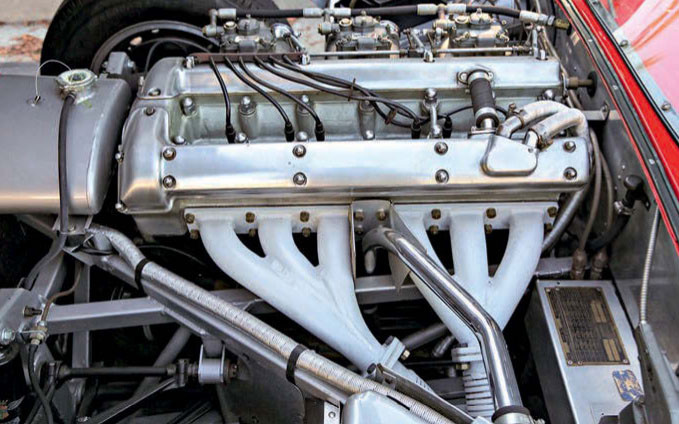
Malcolm Sayer, an expert aerodynamicist who had left the Bristol Aeroplane Company to work for Jaguar, was given a free hand to create the shape of the D-type. He described his design as «functional efficiency at all costs.» Nevertheless, the car's highly effective bodywork, created in lightweight aluminum and perfected in the wind tunnel, was undeniably beautiful, with perfect proportions and compound curves.
“I think it was the best road car that I ever owned. If it started to rain, then at any speed over 50 mph you weren't aware of it.”
“I think it was the best road car that I ever owned. If it started to rain, then at any speed over 50 mph you weren't aware of it.”While so much of the D-type's design broke new ground, the latest Jaguar was powered by a development of the venerable twin-cam, straight-six XK engine that debuted in 1948. Equipped with three Weber carburetors, high-compression pistons, and high-lift camshafts, the D-type's engine produced an estimated 250 bhp and allowed for a top speed in excess of 170 mph, dependent on rear axle ratio.
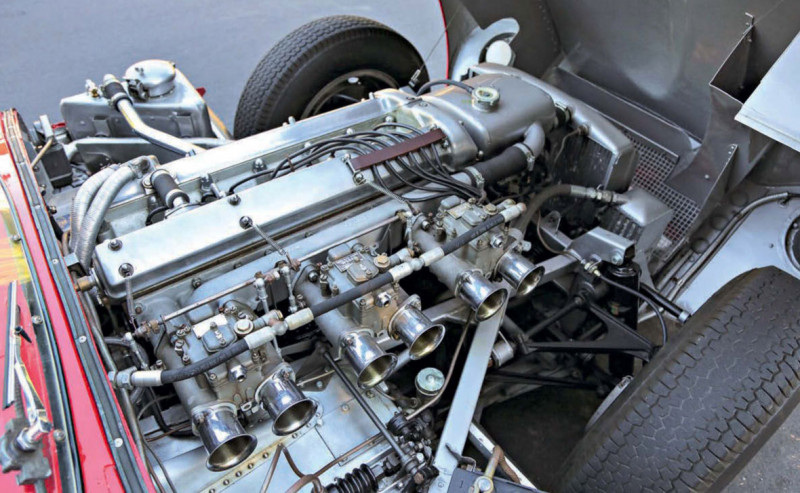
In June of 1954, the Jaguar D-type made its official competition debut at the 24 Hours of Le Mans, creating a sensation. Campaigned at the highest levels of motor racing, the D-type achieved tremendous success during its lifespan. Three overall wins at the 24 Hours of Le Mans (1955, 1956, and 1957), two wins at the 12 Hours of Reims (1954 and 1956), and outright victories at the 1955 12 Hours of Sebring and the 1956 Grand Prix of Spa are among its notable highlights.
Capitalizing on the success of its works cars, Jaguar decided to offer a D-type for customers eager to buy a proven winner. A production line was set up at Browns Lane that constructed 67 cars for private sale, including 16 examples converted to the XKSS road car. With few exceptions, production D-Types were all equipped the same way with the short-nose, Weber equipped configuration. Sales to privateers began in the fall 1955.
In 1956 the editors at Road & Track magazine tested a new D-type for an article that appeared in that year’s May issue. The magazine made their opinion of the new D-type abundantly clear to their readers: “‘A thrill that comes once in a lifetime’ is an overworked cliché, but it describes perfectly our impressions after conducting a full-scale road test on the D-type Jaguar. This is the best performing automobile we have ever tested, and we have tested some very potent machinery. An acceleration time from a standstill to 100 mph in just over 12 seconds is startling enough, but this is combined with a genuine timed top speed of 162 mph!”
In 1956 the blisteringly fast, sensationally styled Jaguar D-type was one of the cars to own if you wanted to be competitive racer.
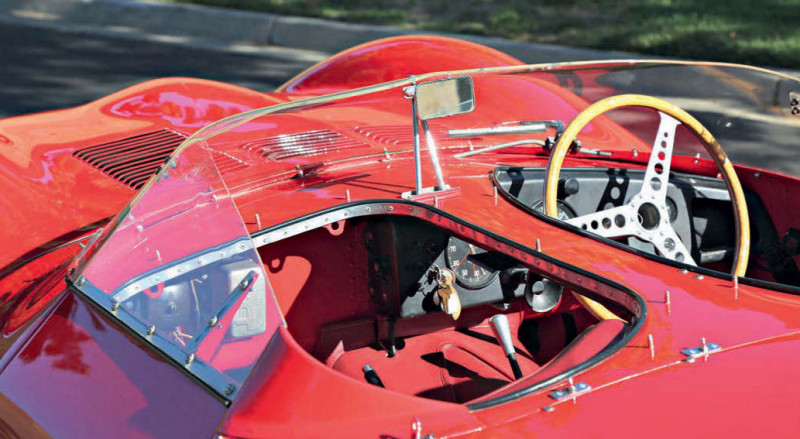
FIRST OWNER
The car featured here, XKD518, was completed in December 1955 and delivered to Jaguar dealer Henlys of Manchester, one of approximately 24 production D-types that would be delivered in the United Kingdom. According to factory records, this car was originally finished in a striking red over red color scheme, making it one of only two Ds produced in this color combination. Henlys had some difficulty locating a buyer for the new red D-type and eventually moved it to a dealer named Bernie Ecclestone.
Bernie Ecclestone’s name would later become synonymous with Formula One, becoming the president and CEO of Formula One Management and Formula One Administration, later becoming part owner of Alpha Prema, the parent company of the Formula One Group of companies. In 1972 he bought the Brabham team, which he ran for fifteen years. As a team owner he became a member of the Formula One Constructors Association. Ecclestone would go on to take Formula One from a niche racing program to a global phenomenon, being dubbed ‘F1 Supremo’ by the British tabloids.
Until the 2017 Liberty Media takeover, Ecclestone was the number one authority in Formula One racing, but in 1956 his business was selling cars. Ecclestone did have some behind the wheel racing experience in the 500cc Formula Three Series, with a Cooper Mk V he purchased in 1951, running it a few times mostly at Brands Hatch. He took a break from racing after colliding with Bill Whitehouse causing him to lose control and come to a stop in the track parking lot.
In the 1950s Ecclestone made a number of lucrative investments in real estate, but always maintained a profitable car business. His Bexleyheathbased car business grew rapidly and he was buying up local dealerships, and remodeling them, creating some of the most attractive showrooms in Southern England and filling them with all types of cars including many sporting cars, attracting buyers looking for something special. One of those attracted to Ecclestone’s smart-looking showroom was Peter Blond.
Blond was a talented amateur racer who had a history of Jaguar ownership starting with an SS100 — a 21st birthday present from his father as a reward for not drinking or smoking. He would later upgrade to an XK120, followed by a ‘lightweight’ C-type.
“Bernie Ecclestone was just a wheeler dealer back then,” Peter Blond recalled in an interview with Classic & Sports Car magazine in England. “He could get his hands on anything you wanted.
Somehow, he found a brand-new D-type, and it turned out to be red. The factory price was £3,378, but he said he would let me have it for three thousand quid. Bernie always made a profit on whatever he sold, so I didn’t ask where it came from. I managed to scrape together £1500 and he let me have the rest on the drip.”
Blond elaborated when he spoke to author and historian Anthony Pritchard, whom he told about his purchase and first race with XKD518: «I used to go to Warren Street quite frequently, and with new cars in short supply and the bulk of production being exported, it was a haven for available cars. It was early 1956 that I was struck by the sight of this amazing red D-Type and the young man called Bernard Ecclestone, who had a small office there, a sort of box with a secretary in it. It was already registered KDB 100 when I bought it. It was brand new and was offered to me for £3,000, which was not a bad price as Brian Naylor in Stockport was offering one for £3,750 at about the same time.
As I had enjoyed my C-type so much, it seemed a natural progression, and it didn't cost all that much more money. It had of course a single windscreen round the cockpit and an alloy cover over the passenger seat. I think it was the best road car that I ever owned. If it started to rain, then at any speed over 50 mph you weren't aware of it. I used to wear a crash helmet with a visor, which was so much better than goggles because you could wipe the visor and if it started to mist up, you just lifted your head and the breeze cleared it.
My first race with the D-type was on 14th April 1956, when I drove it in the British Empire Trophy at Oulton Park. It was a proper road circuit, and I liked the fact that the D-type seemed very happy there, particularly in the dry. It was my local circuit and I came to know it quite well. It was a very testing circuit — if you went off, you were quite likely to go into the lake or hit a tree. I finished fifth in the heat for cars over 3000 cc, ahead of Ken Wharton with Joakim Bonnier's Alfa Romeo Disco Volante.»
Blond continued to race his red XKD518 about a dozen times profit on whatever he sold, so I didn’t ask where it came from. I managed to scrape together £1500 and he let me have the rest on the drip.” Blond elaborated when he spoke to author and historian Anthony Pritchard, whom he told about his purchase and first race with XKD518: «I used to go to Warren Street quite frequently, and with new cars in short supply and the bulk of production being exported, it was a haven for available cars. It was early 1956 that I was struck by the sight of this amazing red D-Type and the young man called Bernard Ecclestone, who had a small office there, a sort of box with a secretary in it. It was already registered KDB 100 when I bought it. It was brand new and was offered to me for £3,000, which was not a bad price as Brian Naylor in Stockport was offering one for £3,750 at about the same time.
As I had enjoyed my C-type so much, it seemed a natural progression, and it didn't cost all that much more money. It had of course a single windscreen round the cockpit and an alloy cover over the passenger seat. I think it was the best road car that I ever owned. If it started to rain, then at any speed over 50 mph you weren't aware of it. I used to wear a crash helmet with a visor, which was so much better than goggles because you could wipe the visor and if it started to mist up, you just lifted your head and the breeze cleared it.
My first race with the D-type was on 14th April 1956, when I drove it in the British Empire Trophy at Oulton Park. It was a proper road circuit, and I liked the fact that the D-type seemed very happy there, particularly in the dry. It was my local circuit and I came to know it quite well. It was a very testing circuit — if you went off, you were quite likely to go into the lake or hit a tree. I finished fifth in the heat for cars over 3000 cc, ahead of Ken Wharton with Joakim Bonnier's Alfa Romeo Disco Volante.»
Blond continued to race his red XKD518 about a dozen timesthrough mid-1957. Successes with the car included a 5th Overall at the Aintree 100, a top 10 finish in the Goodwood Trophy, and a win at the Snetterton National Race.
Blond decided to sell the D-type to his cousin, Jonathan Sieff, who purchased XKD518 from him in summer 1957, subsequently entering it in the BARC race at Goodwood in August, placing 5th Overall. He and Blond campaigned the car with good results through 1959, even taking the car to Austria in May 1958 for the Aspern airport race.
At the conclusion of the 1959 season, Monty Mostyn of Speedwell Garage acquired XKD518, registered it as MM 2, and sold it to John Houghton, creator of the Biota, a Mini-based sports car. Shortly afterward, Houghton sold the car to one of the most prominent female race car drivers of the era, Jean Bloxham. Bloxham, had successfully driven both Aston Martin DB2 and DB3S in many races during the late 1950s. On the advice of Jaguar's competition manager ‘Lofty’ England, Bloxham bought the D-type. She raced XKD518 at Goodwood and Silverstone and recalled that «it was a very comfortable road car, smooth, powerful and with a superb gearbox.»
In 1962, she sold the D-type back to John Houghton after her husband Roy was killed driving a Lister-Jag. In 1967 the car was acquired by John Coombs and Richard Wilkins, who sold it to Clive Lacey. During Lacey's stewardship, XKD518 participated the first International E-Type Day at Donington Park in 1974. Few years later, the Jaguar was sold, throughAdrian Hamilton, to Peter Grant, the manager of rock band Led Zeppelin.
Grant worked for Don Arden in the early 1960s, managing British tours of foreign artists. In 1966, he founded RAK Music Management with producer Mickie Most and began managing the Yardbirds. When that group broke up in 1968, its guitarist, a young Jimmy Page, brought Grant along to steer his next group, the mighty Led Zeppelin. Page and the other members of the group were car enthusiasts and purchased some interesting and sporting cars after they became successful. Somewhere around 1977, Grant purchased the D-type. How exactly the large, six-foot five, 300- pound former wrestler fit into the tight cockpit of the D remains a mystery!
STATESIDE JOURNEY
Two years after Led Zeppelin’s breakup in 1982, Grant sold XKD518 to American collector George Stauffer, who reportedly kept the Jaguar as a display in his office, keeping the car for 14 years. Stauffer owned the car until 1996 when he sold it to Chris Cox of North Carolina. Two years later Cox moved it on to Roger Willbanks of Denver. Don Williams of the Blackhawk Collection acquired XKD518 in 2008 from well-known enthusiast Bill Jacobs.
At some point during the D-type’s history it was repainted British Racing Green and the seats recovered in black leather. A photo from 2008, soon after it was acquired by Williams, shows the car in excellent condition, with just some road rash paint chips on the front of its green nose.
“We did some research and verified XKD518 was originally one of the two red on red D-Types produced by the factory.” Explains Don Williams. “It is such a rare and historic car. I decided it should be returned to its original livery.” During the restoration, it became evident that the car had never been ina serious accident and the body was in remarkably original condition. It was also confirmed that the car retained its matching-number drivetrain. For a racecar to have never been wrecked and still have all its original major mechanical components intact is rare indeed. Since its restoration, XKD518 has been exhibited from time to time by its current owner at the Blackhawk Museum in Danville, California.
DRIVING THE D
I recently got a rare opportunity to both ride in and drive XKD518 to and from my photo shoot of the car. I first rode as passenger. Entering a D-type requires some planning. Not wanting to brace myself anywhere on the lightweight aluminum body, I opened the passenger door that weighs less than my camera lens and gingerly eased myself into the cockpit (I’m glad I take Pilates classes!) after several attempts to figure out just where to place my left hand, my right leg, etc. After I was seated, I carefully shut the door and latched it. I soon realized passenger leg room was not a priority when this car was designed. Sitting crouched up like a ball, clutching my camera, I was too exited to care when the D’s twincam, straight-six powerhouse fired-off, making a raucous racket out the sidepipe just outside my door. Just riding in this magnificent beast was a thrill, but driving it was even more amazing.
The driver has considerably more leg room than the passenger and once seated, I found it cozy but comfortable. I hit the switch and the car came to life instantly. The clutch is heavy, but not excessively so, engaging right where it should and having a great feel. The shifter is short in length, snaps positively into each gear and shifts precisely. At slow speed it bounces a little until it reaches speed and smooths out nicely.
It is easy to drive at low speed, but there is no doubt it wants to run. The steering feels solid, tight and nimble. The engine says “Go faster! Go faster!” In fine tune, and with so much power on tap, accentuated by the unique, amplified Jaguar race exhaust, I wanted to do just that. However, the car was not mine, I was not on the track, and I would like to remain friends with the car’s caretaker as well as the local police department, so a high-speed run was not in the cards. Still, driving a D-type is an event in my life I will ever forget, and a bucket-list check-off.


